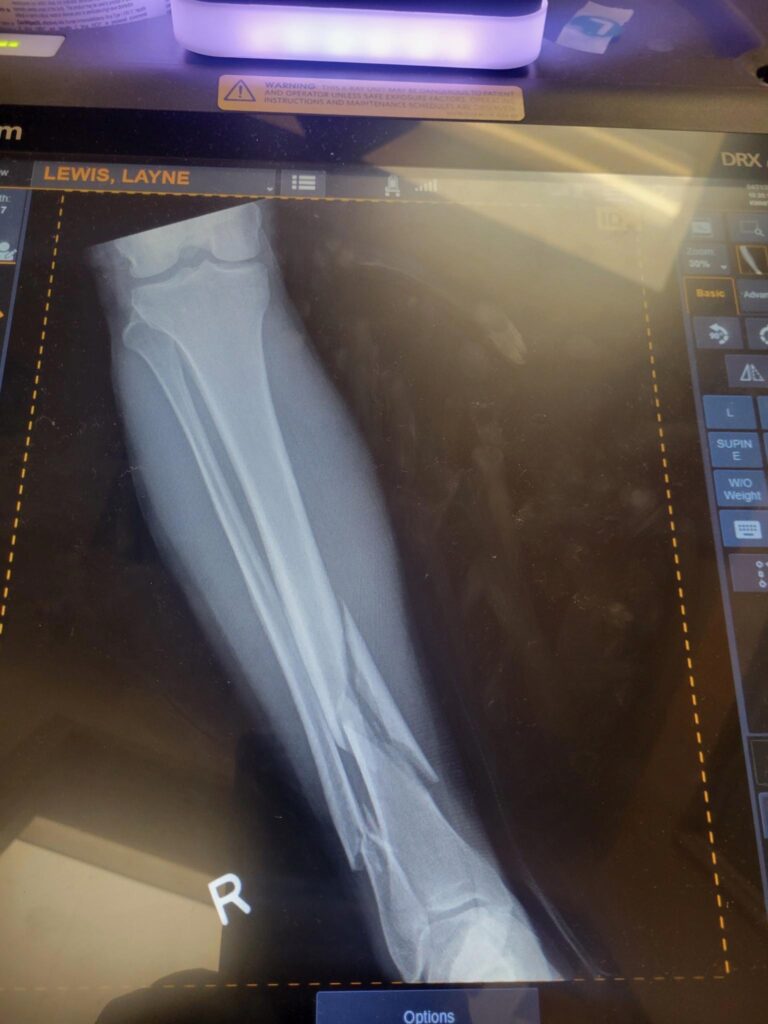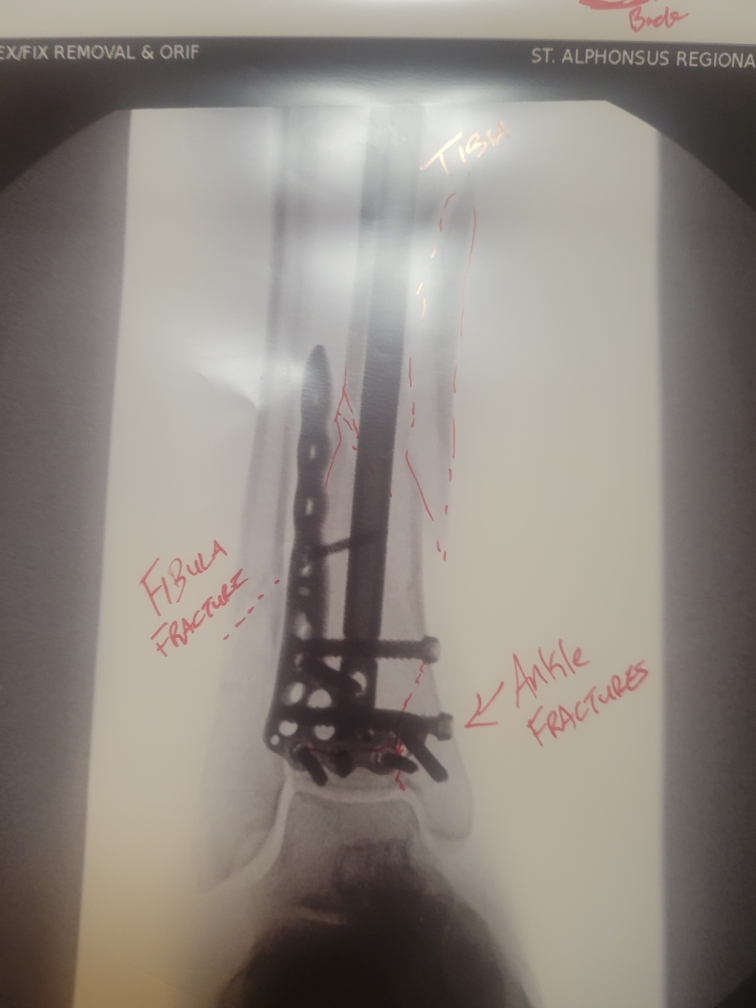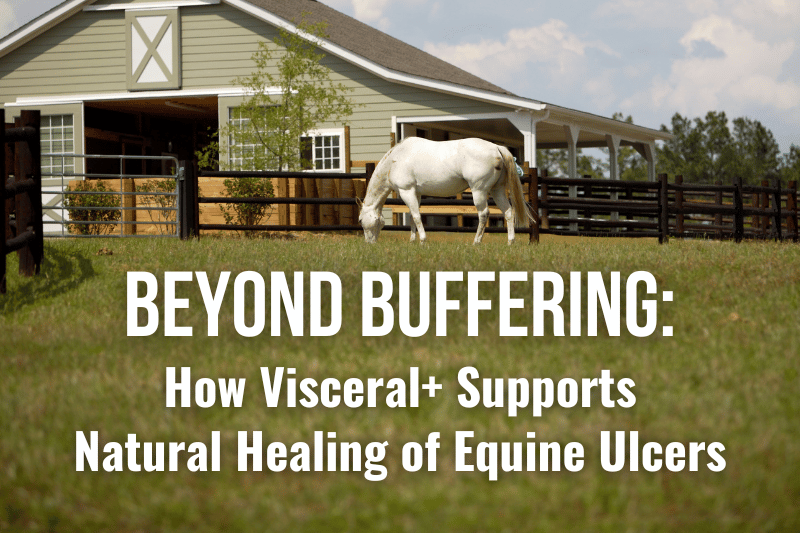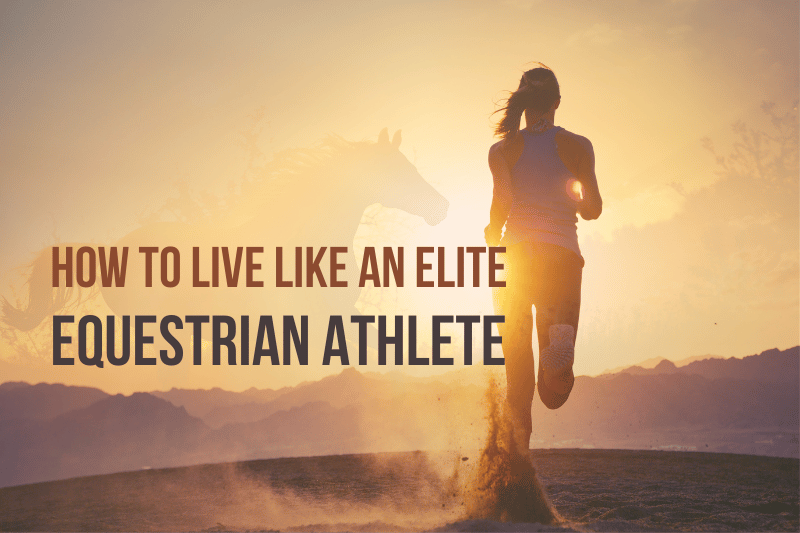The Burlington airport, charming with its rocking chairs and backlit bottles of maple syrup, busted around me, but all I could hear was my friend Layne’s voice echoing over the phone.
“I have to have another fusion.”
What?! Not again!
You know from Part 1 that Layne Lewis had spent the past year healing from a lumbar spine fusion in the wake of spondylolisthesis caused by osteoarthritis. A lifelong endurance athlete both in the saddle and out, Layne went from not knowing whether she’d walk again to completing two 100-milers on her extraordinary young horse, Atlas.
And now, this.
Let’s return to my interview with Layne Lewis:
The Sweaty Equestrian: You seemed to be doing so well. What went sideways in fall 2023?
Layne Lewis: Around August, I started getting some numbness in my right arm. I thought I was just sleeping wrong on my shoulder, but it got more persistent. I moved up an appointment with my neurosurgeon. “It’s not your shoulder,” he said. “You need another MRI.”
So I got the MRI, and it showed I had osteoarthritis issues in my cervical spine similar to the ones in my lower spine. You’ve got to be kidding me. I’m pretty sure I shed a tear. Talk about not being ready for this one!
My body had already auto-fused C5 and C6, but it looked like the neurosurgeon was going to have to fuse C6 and C7 as well.
We tried physical therapy, but by fall we realized it wasn’t going to work. I was devastated.
TSE: You'd always been so athletic and taken care of your body. It had to feel like a betrayal for osteoarthritis to hit you like this. How did you deal with that struggle?
LL: For whatever reason, I did very well accepting the first surgery, but this one was such a shock to me. I felt like my body was eating itself up from the inside. I started really getting inside my head, thinking, I have osteoarthritis and all my joints are going to fail.
I really had to work hard at the mental aspect. Come on, I told myself. You can still do things today.
It was a shift to say, “I may not have control over what my body is doing, but I’m going to do what I can to make it the best for me today.” That includes doing my fitness routine. It includes changing my diet. It includes continuing to do some of the things I love – but not all. I had to make choices.
For example, the neurosurgeon advised that I not run. I said, “But I love to run!”
Then I thought, I’ve run a lot, I’ve done a lot of marathons. And the doctor has experience worth listening to. I chose horseback riding instead. And yes, it’s hard on my back, but not as hard as running. I accepted that I just have to make choices now that I didn’t have to before.
I had to shift my mindset from 18-year-old-athlete-with-everything-ahead to 55-year-old-former-athlete-with-osteoarthritis. People talk about having a glass half full or half empty, but it was beyond that for me. I got to the point where I was just glad I had a glass.
So I did feel betrayed because I had thought I was doing everything I could do. I did heavy weightlifting for years. I ran. I did Ironman triathlon. My bones are really strong! (I don’t have osteoporosis; I have osteoarthritis.)
But when all this happened, I did some research and it turned out I wasn’t doing everything right, after all. I was eating in a way that ignored inflammation markers. I realized that if you start looking at granola bars and energy bars, what they’re made of is not going to help my body any.
I also learned that the auto-fusing in my cervical spine isn’t common. It’s actually an auto-immune reaction. Clearly, I needed to understand what my body was doing a little better.
I found a naturopath doctor to do bloodwork and a battery of tests, whilst also changing to an anti-inflammatory diet. No matter what else I was doing, anti-inflammatory is the way to go.
TSE: What does "anti-inflammatory" mean in real life? What happens in your kitchen?
LL: No refined sugar, and frankly, nothing refined. We don’t eat anything out of a box.
I felt better within days of getting rid of sugar. All I use for sweetners are honey and maple syrup. I cut out all the refined flours and things. Gluten is another one I avoid.
You have to take out all the foods that might cause you problems, as an individual, and add them back to determine which foods work for you.
Here’s how an elimination diet works: First, remove all the common problem foods from your diet for 30 days. Even a tiny bit will affect your results, so be strict. Common problem foods include eggs, nuts, dairy, sugar, wheat and other gluten-containing grains, and legumes, including soy. If you suspect any other foods (and it can be anything, including particular meats or veggies), go ahead and remove those as well.
After 30 days, add back one food per week and pay attention to any symptoms. Do you feel more fatigued? Do you get brain fog? Do your joints ache? Do skin issues crop up? Do you experience gut or autoimmune symptoms that had abated during the 30-day elimination? If so, the food you added back may be an issue for you.
As a reminder, I’m not a medical professional, so take this as general advice. A qualified naturopath or functional medicine doc can help you with a personalized problem-solving approach.
TSE: Do you ever eat sugars or refined foods these days?
LL: I do, because I live. The interesting thing is that I can tell when I eat them. If I have cake or pie with family on the holidays, the next day the pain in my hands is back. Sometimes it’s worth it for a special occasion, but not every day.
TSE: So this isn't a religion. It's choices and consquences.
LL: Right. What’s nice is that so many people are eating this way now, it’s pretty easy to find anti-inflammatory choices, even at restaurants. Anti-inflammatory eating is just a healthy way to live.
TSE: You mentioned that you also work with a personal trainer. How much time do you spend on the physical exercises associated with your recovery from two spinal fusions?
LL: I do mobility work no less than twice a day, in the morning and evening, for 10-15 minutes per session. Plus I strength train twice a week, walk a lot, and ride. It’s a commitment, but I know that it’ll enable me to do the things I want to do. I also just feel better when I do it.
TSE: You're now five months out from your second surgery, and back in the saddle. What exercises do you do specifically before and after riding?
LL: Early on, I would always walk my horse in hand for at least a mile. I have something I call the wiggle-walk, where I move my hips more than I would normally. Then I’d get on the horse and ride at a walk for at least another mile. I’d do some stretching up there, too.
Now I don’t do the walking as much, but I do ice my lower back and neck as soon as I’m done with the ride. That has been critical.
I don’t take anti-inflammatories at all unless I’ve had a big increase in activity. Then I might take a naproxen and the muscle relaxer prescribed by my neurosurgeon because I don’t want my body to go back into fight mode where it tries to hold onto the tension.
TSE: How did you learn to sort out when you're pushing too hard versus not hard enough?
LL: I think I’m still figuring it out.
For example, two weeks ago, I felt so good riding that I thought, “Oh, I’m going to increase my lifting a little more.”
When I increased the amount of weight I was lifting at the same time I was increasing my riding hours, I got more sore than the level of work warrented. That was my body telling me I need to do one or the other, but not both. So I took a week off to recover and started over. Part of the learning is experimental.
I’m still trying to figure out my new normal. I feel strong and riding is good, so that makes me happy, but it costs me. I’m sore the next day. I’m hoping at some point I won’t have to choose whether to ride or go for a walk, but that’s where I am.
Also, I’ve learned that recovery is as important as the workout itself. That’s a change from the younger me. Before, I didn’t see rest as an equally important leg in the triad – I saw strength and endurance as more important than recovery – but boy is it equal, and certainly now!
TSE: You're planning to ride a 50 in a couple weeks. What mid-ride strategies will you use to get through that?
LL: I’m going to do three things for sure: I’ll stretch before, during, and after. I’ll ice after and at the holds, and I’ll preemptively take an anti-inflammatory. The stretching in the middle is critical, even on the trail anytime I get off. You’ll often see me stand in the stirrups and stretch in the saddle. And I feel so much better when I ice for hours and hours after.
I’m not expecting to go any particular speed, and I’m very capable of pulling myself if I need to. I finally have my head around the idea that I’m going to be the best me I can be today. Sometimes that might mean not finishing. Sometimes that might mean making the choice to not ride, and I’m okay with that.
That’s very different from the me of 20 years ago, when I might have seen that as a failure. Now, I see it as a strength. Knowing my limits is just as important as knowing my capabilities.
TSE: Let's talk about the horse you're going to be riding.
LL: Atlas is a unicorn. He’s very fit and well-bred, but he’s also very ratable, which is why I’ll ride him and not anybody else. I need to be able to go the speed that feels right to me, and I need to be able to walk sometimes.
I do struggle because this particular ride is in my back yard and sometimes my horses want to go home. I might have my hands full!
TSE: In a future conversation, we're going to cover what you did in your past that contributed to your ability to get through these surgeries, so others can consider implementing those practices as well.
For now, though, speak to someone who is already facing a serious diagnosis, be it spinal surgery or anything else. What would you say to them?
LL: I would say you 100% can recover, though you may not know the exact level you’ll recover to. Here are two things you can do immediately in that situation:
First, look at your diet and see if there’s anything you can do to make yourself feel better.
Second, talk with your physical therapist and surgeon and find out what you can do now to get your body trained for that surgery. I think there’s a lot we can do to prepare in advance to support recovery of both body and mind.
Also, find people like me. Others have successfully navigated this. There are more of us than you realize. Atlas and I just came in from a 23-mile ride. I now have 12 screws, 1 plate, 2 cages, and 2 rods in my spine. And I just rode, no problem!
I’m not saying it’s easy. Some days are harder than others, and I certainly have to work a lot harder than 20 years ago when I just hopped on a horse and went riding and then ran 10 miles. I can’t do that anymore.
But that’s okay! It’s okay.
TSE: By the way, what race did you sign up for this year?
LL: Oh yeah. Tevis. That one.
I want to see if we can do it. I may not have a lot of years left in me, but I’ve done it once before and I want to do it again with Atlas. I think he’s got the right mindset to carry me through and I really want to try.
That was where Layne and I left our conversation on April 9, 2024. We had plans for further interviews as Tevis approached. She would ride, I would join a group of very experienced crew from our region, and we’d bring you all along on the adventure.
And then…
The morning of that endurance ride in Layne’s backyard arrived. She mounted up and I waved her off, then turned back to tacking Jammer up for the LD. We’d just started our warmup when word flew back into camp. Something about Layne being down. A broken ankle.
The language I used at that moment may have stretched the limits of social nicety. But you know how these things are. Rumors, misinformation… Who knew what was really happening?
By the time the LD started and we set out down the same trail, Layne and Atlas were nowhere to be seen. No emergency vehicles had gone by. Maybe they were okay?
Mid-loop, we came across one of Layne’s sons on a ridge, radio in hand. He had news: Tib-fib fracture. En route to a bigger hospital. Surgery pending.
My heart dropped right through Jammer onto the trail.
Our friend Jen, who was riding with us, and I discussed heading straight back to camp and to the hospital. Ultimately, we concluded that we wouldn’t be of any practical use, and Layne would want us to continue the ride. So we did, periodically pausing to exchange texts with Layne’s husband.
The only good news was that Layne was in good spirits.
Really, she was! Despite this:

Which, over a week later, became this:

It’s funny, isn’t it, how much better we can become when we choose to focus on the positive?
I’m pretty sure I would not have handled yet another setback with the extraordinary grace and gratitude that Layne has…but I hope that if I ever need to, I’ll be able to live up to her example.
Meanwhile, Atlas is completely fine. Remember how Layne had known he might be fussy about starting a ride so close to home? Sure enough, the accident occurred when he lost his balance or tripped during some impatient head-tossing.
He fell, taking Layne down with him. We think her leg must have gotten crushed either by the stirrup under Atlas’ side, or by his hoof as he scrambled back to his feet.
Another rider kindly untacked him and one of the fabulous ride vets checked him over, then turned him out in his pasture. He promptly resumed playing with his buddy and wasn’t even sore the next day.
Anyway, Layne is as mentally and physically prepared as anyone can be to face yet another recovery, and I’ve no doubt she’s going to ace it.
In the meantime, our upcoming summer looks different:
-
- Layne is embarking on three months of strict non-weight bearing recovery for that leg.
-
- I will be taking over as Atlas’ endurance partner, which is a great and humbling honor.
-
- In a surreal turn of events, I’m now registered for Tevis 2024, with Layne as my mentor and coach.
-
- You still get to come along for the adventure! Stay tuned for posts on everything I’m exploring, including specific physical preparedness for the rigors of the Western States trail. It’s going to be a wild ride.




Tamara, I’ve really been enjoying your entire blog. As a new-to-endurance rider, I appreciate the content.
Layne….. you are in my heart. Keep up the fight!